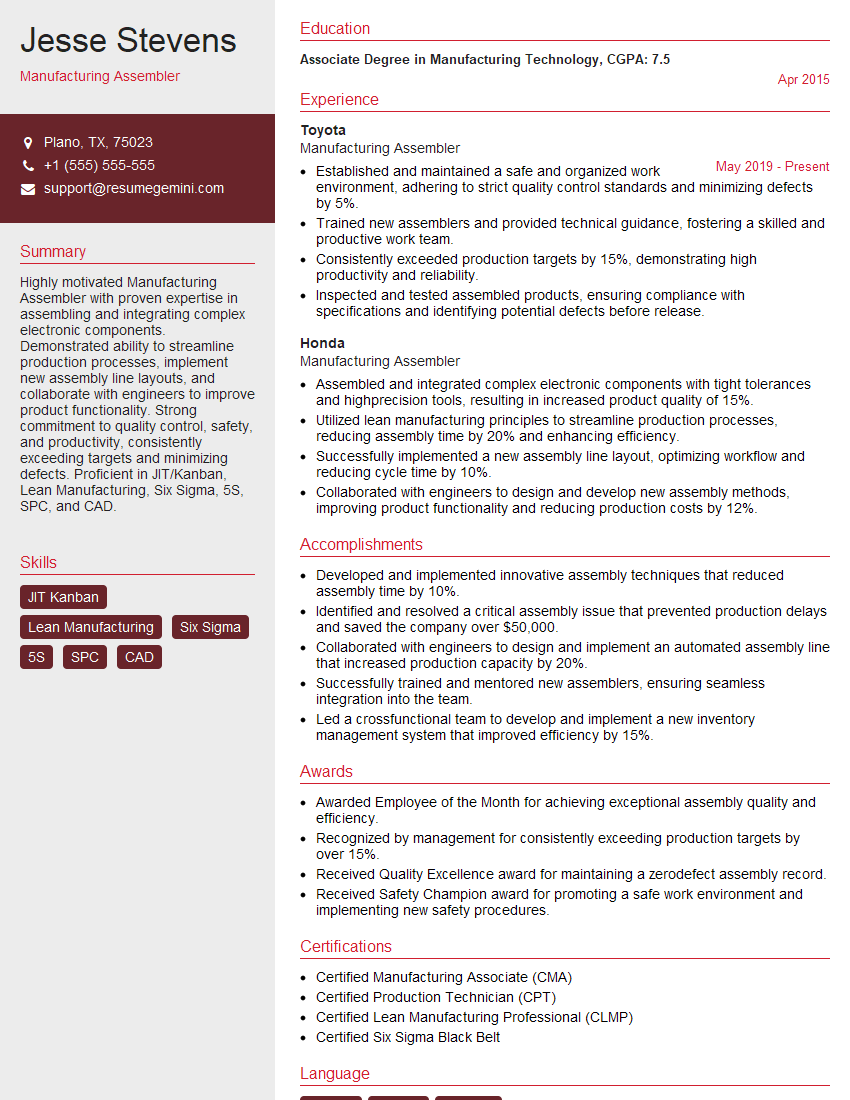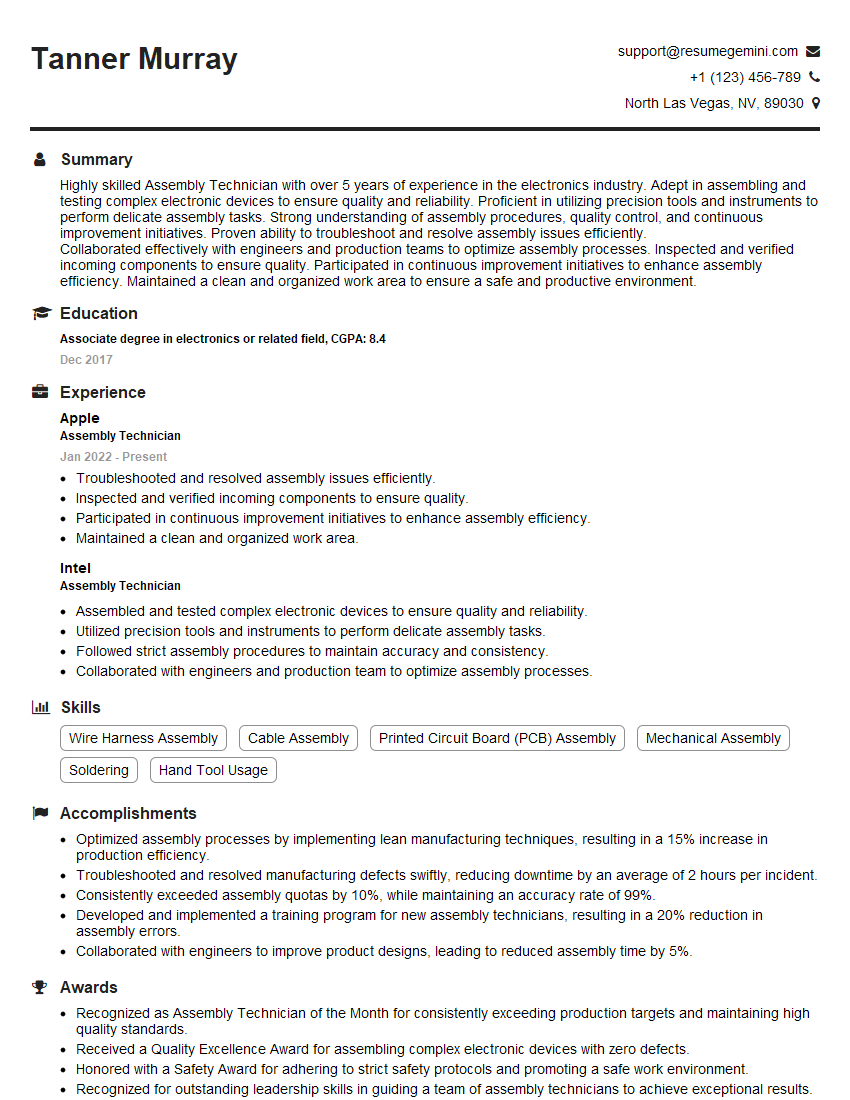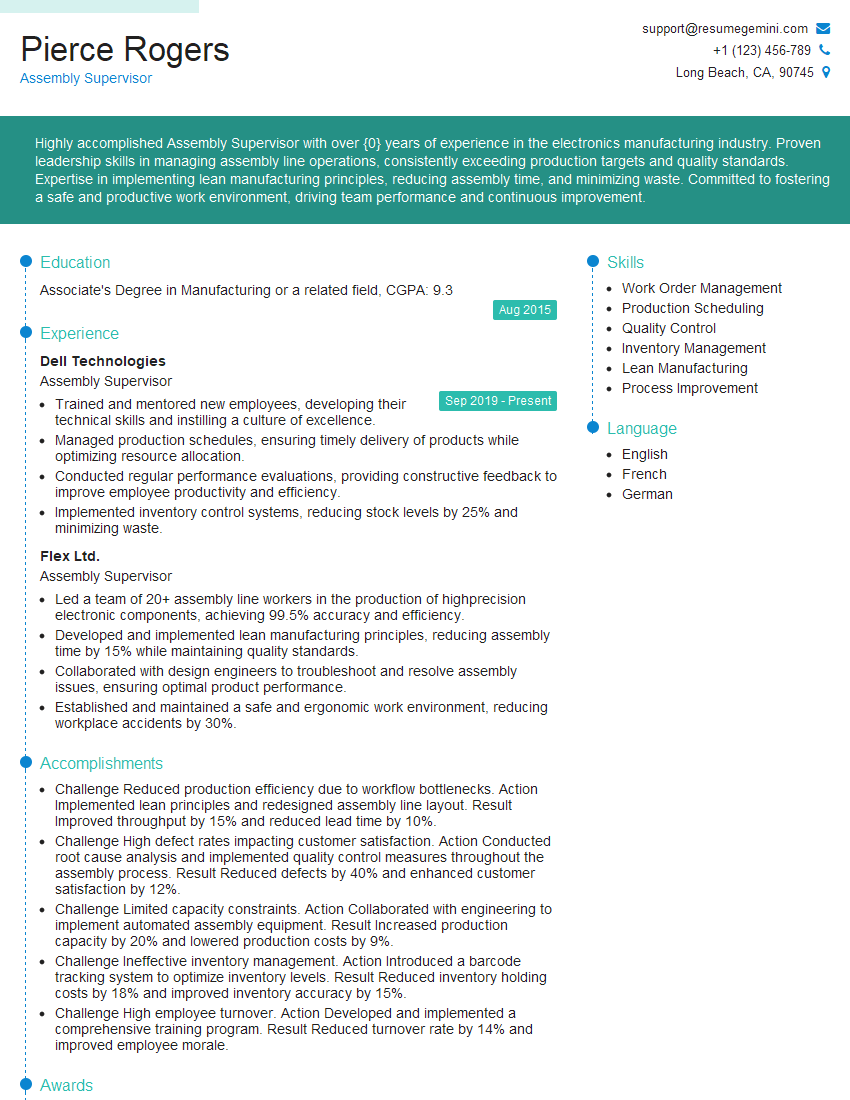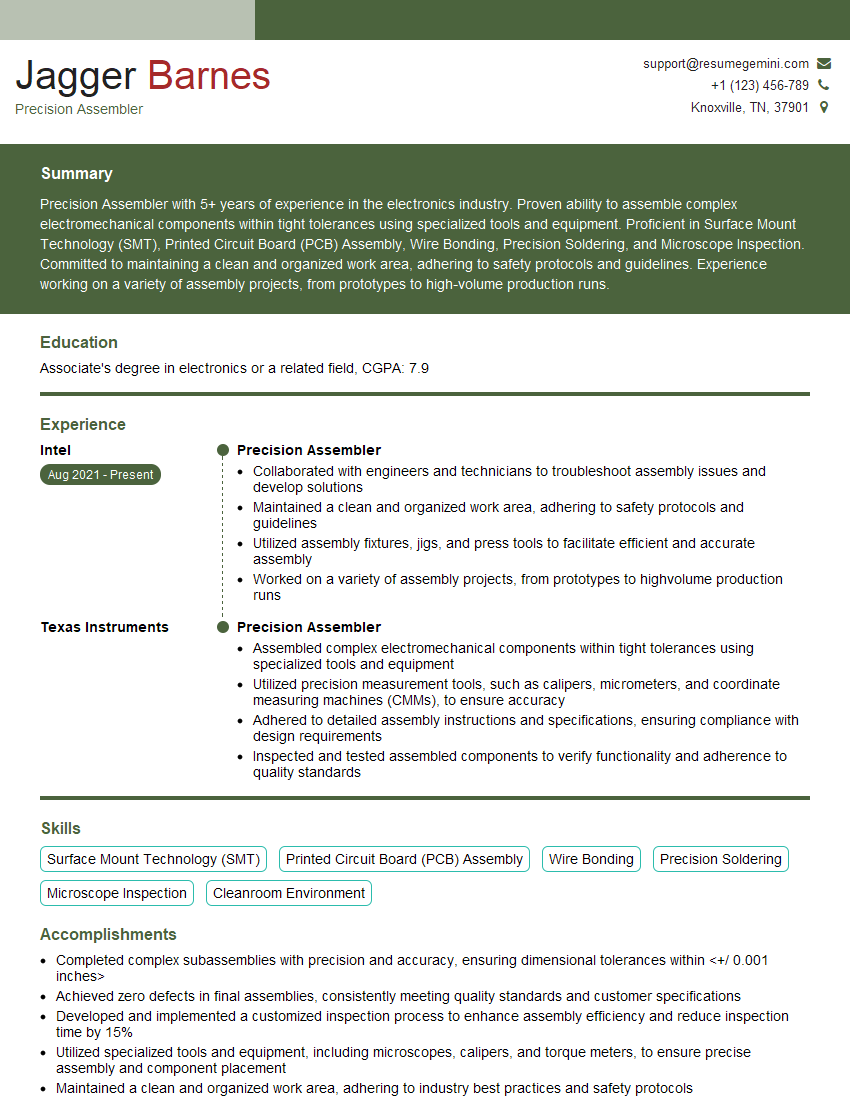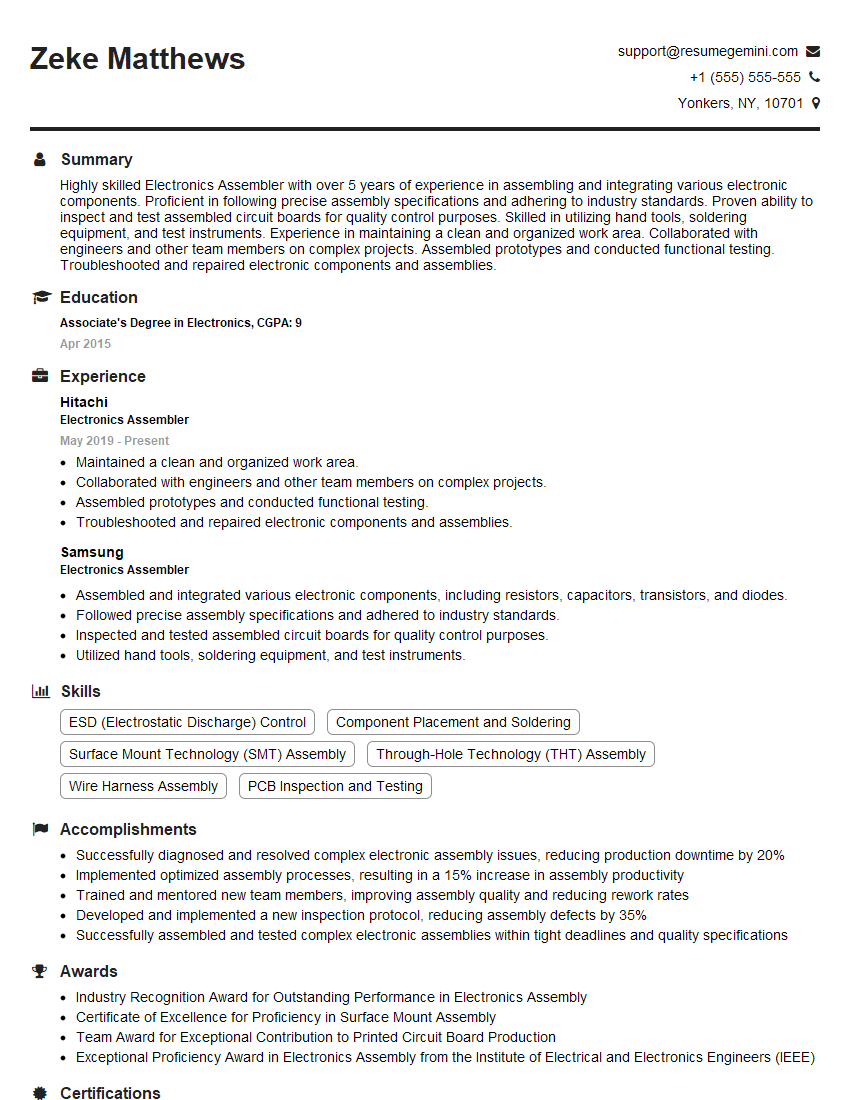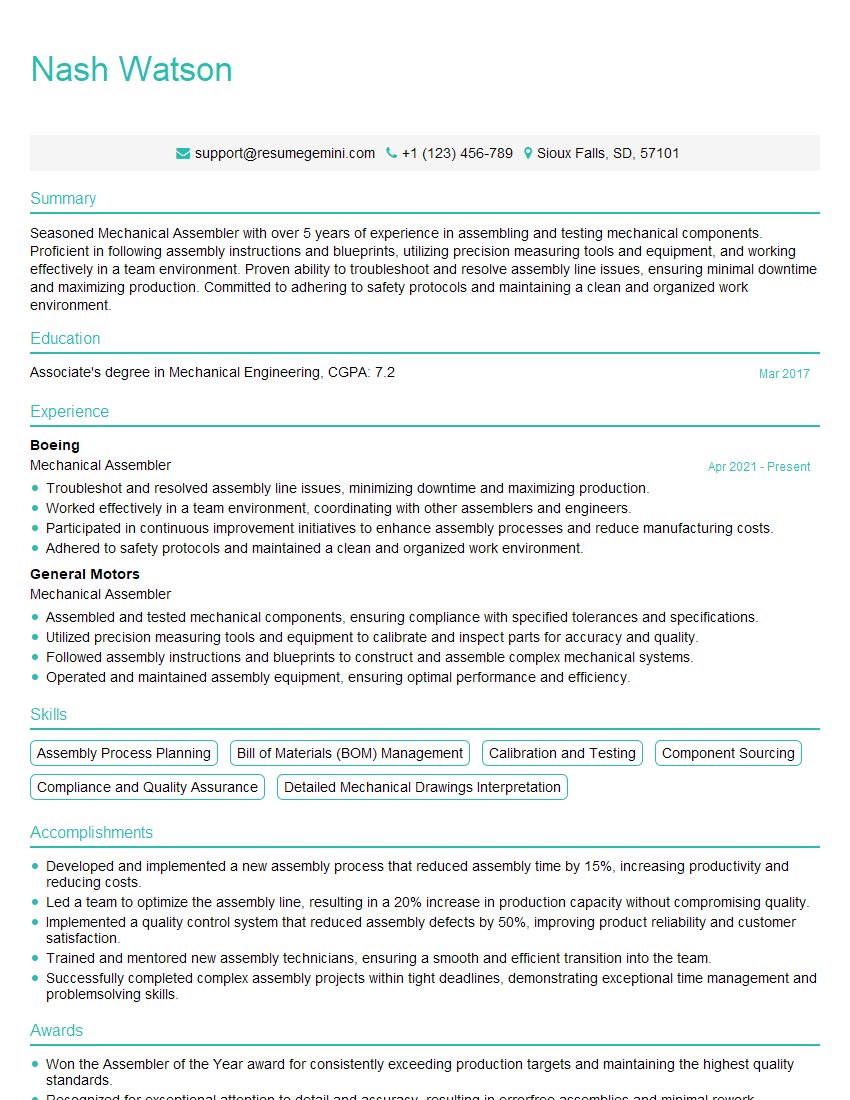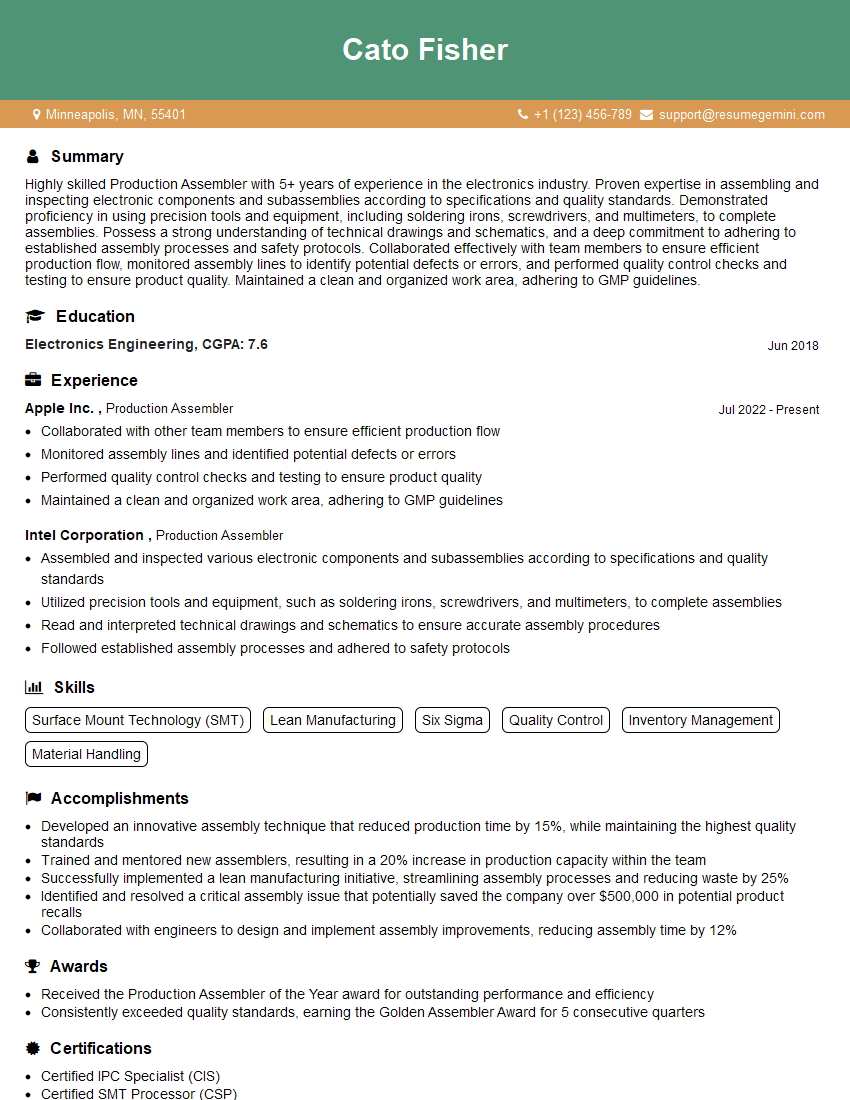Every successful interview starts with knowing what to expect. In this blog, we’ll take you through the top Metal Part Assembly interview questions, breaking them down with expert tips to help you deliver impactful answers. Step into your next interview fully prepared and ready to succeed.
Questions Asked in Metal Part Assembly Interview
Q 1. Describe your experience with different types of fasteners (bolts, screws, rivets, etc.).
My experience with fasteners spans a wide range, encompassing various types and applications. I’m proficient with bolts, ranging from simple machine bolts to specialized high-strength bolts used in critical applications. I understand the nuances of different bolt head styles (hex, socket, flanged) and thread types (metric, unified). Screws, another staple, require understanding of drive types (Phillips, Torx, etc.) and their torque requirements to avoid stripping. I have extensive experience with rivets, both solid and semi-tubular, understanding their use in permanent joining applications and the importance of proper rivet setting techniques to achieve a secure and flush joint. I’m also familiar with specialized fasteners like lock washers, self-tapping screws, and inserts, choosing the appropriate fastener for each specific material and application is crucial to ensure structural integrity.
For example, in assembling a complex robotic arm, the choice of fastener is critical. High-strength bolts with lock washers are essential for joints experiencing high stress, while less critical connections might use self-tapping screws for ease of assembly. The understanding of material compatibility is also key; using stainless steel fasteners in a marine environment prevents corrosion, ensuring longevity.
Q 2. Explain your experience with hand tools and power tools used in assembly.
My experience with hand and power tools is extensive, covering a broad spectrum of equipment commonly used in metal part assembly. Hand tools are essential for precise work and include various wrenches (open-ended, box-end, adjustable), screwdrivers, pliers, punches, and measuring tools like calipers and micrometers. Proficiency with these tools ensures accurate fastener tightening and manipulation of small parts. Power tools increase efficiency, and I’m experienced with impact wrenches for high-torque applications, drill presses for creating precise holes, and pneumatic rivet guns for rapid and consistent rivet setting. Safety is paramount; I always adhere to safety regulations and use appropriate personal protective equipment (PPE), such as safety glasses and gloves.
For instance, when assembling a delicate electronic component, I’d use precision hand tools to avoid damage. On the other hand, assembling a large chassis might involve using an impact wrench to speed up the process, significantly improving productivity.
Q 3. What are your preferred methods for ensuring precision and accuracy during assembly?
Precision and accuracy are paramount in metal part assembly. My preferred methods revolve around meticulous planning and execution. Before assembly, I carefully review blueprints and technical drawings to fully understand the design and component specifications. I use high-precision measuring tools such as digital calipers and micrometers to verify component dimensions and ensure alignment. Jig and fixture usage is also crucial for repeatable and accurate assembly, especially for complex parts. Finally, torque wrenches are indispensable for controlling the tightening force of fasteners, preventing damage and ensuring consistent joint strength. The use of visual aids and checklists helps prevent errors and ensures consistent quality.
For example, assembling a gear train requires precise alignment to avoid meshing issues. Using a jig to guide the placement of gears guarantees consistent positioning, and a torque wrench prevents over-tightening that could damage the gears.
Q 4. How do you handle discrepancies or errors found during the assembly process?
Discrepancies or errors are addressed systematically. Upon detecting an issue, I first identify the root cause through careful inspection and comparison with the blueprint. This might involve using measuring tools to verify dimensions or visually inspecting the components for damage. Once the cause is identified, I determine the best course of action, which may involve replacing faulty components, adjusting alignment, or rectifying the assembly process. Proper documentation of the error, corrective actions, and lessons learned is crucial for future improvement and preventing recurrence. If the error is significant, I immediately escalate the issue to my supervisor to assess the potential impact and guide the solution.
For instance, if a bolt hole is misaligned, I might need to carefully re-drill the hole, ensuring precise alignment before proceeding. A significant assembly error might require replacing the entire sub-assembly, thereby preventing any compromise on quality.
Q 5. What experience do you have with blueprint reading and technical drawings?
I possess a strong foundation in blueprint reading and technical drawings, crucial for effective metal part assembly. I can interpret various types of drawings, including orthographic projections, isometric views, and section views. I’m adept at understanding dimensional tolerances, material specifications, and surface finish requirements. I can extract relevant information efficiently and apply it to the assembly process, ensuring compliance with design specifications. My experience also includes interpreting symbols, annotations, and other notations common in technical drawings.
An example is interpreting a cross-section view to understand the internal structure of a part and its relationship to other components. Understanding tolerances is crucial; a tolerance of +/-0.1mm may require different assembly techniques than a tolerance of +/-1mm.
Q 6. Describe your experience with different assembly techniques (e.g., press fits, interference fits).
My experience encompasses various assembly techniques, including press fits and interference fits. Press fits involve inserting a component into a slightly smaller opening, relying on friction to create a secure connection. This technique is often used for bushings and bearings, ensuring a tight fit without the use of fasteners. Interference fits, a more precise version of press fits, involve even tighter tolerances, requiring specialized tools such as presses to create a permanent connection. I’m also familiar with other techniques such as threaded fasteners, welding, and adhesive bonding, selecting the most appropriate method based on the specific application, material properties, and desired joint strength.
For example, assembling a shaft and bearing using a press fit relies on the precise dimensions of the shaft and the bearing bore. An interference fit is more suitable for applications requiring higher strength and is typically used in aerospace or automotive applications where reliability is paramount.
Q 7. How do you ensure the quality of your work throughout the assembly process?
Quality assurance is integrated into every step of my assembly process. I use various techniques, including visual inspection, dimensional checks with measuring tools, and functional testing where applicable, to ensure the integrity of each joint and the overall assembly. Adherence to documented procedures and work instructions is paramount, ensuring consistency and minimizing errors. I regularly calibrate my tools to maintain accuracy and maintain a clean and organized workspace to prevent accidental damage or loss of parts. Thorough documentation, including recording each assembly step, is essential for traceability and accountability. In addition, I consistently review quality control standards to ensure I meet or exceed expectations, ensuring the final product meets or exceeds the specified quality requirements.
For instance, after assembling a circuit board, I would perform a visual inspection to check for correct component placement and soldering quality before testing the functionality of the board. This multi-layered approach guarantees a high-quality, reliable final product.
Q 8. What is your experience with using assembly jigs and fixtures?
Assembly jigs and fixtures are essential tools in metal part assembly. Jigs guide the assembly process, ensuring consistent part placement and alignment, while fixtures hold parts securely during assembly operations. Think of a jig as a template and a fixture as a clamp – both work together to make the job easier and more accurate.
My experience spans working with various types, from simple hand-held jigs for smaller components to complex, CNC-machined fixtures used in automated assembly lines. For example, I’ve designed and implemented a jig for precise alignment of small pins into a housing, dramatically reducing assembly time and error rate. In another project, I utilized a fixture incorporating pneumatic clamping mechanisms to secure several parts during welding, ensuring consistent weld quality and operator safety.
I’m proficient in selecting appropriate jig and fixture designs based on factors like part geometry, material properties, production volume, and cost-effectiveness. This includes understanding design for manufacturing (DFM) principles to ensure efficient production. My expertise extends to the maintenance and troubleshooting of existing jigs and fixtures as well.
Q 9. How do you manage your time and prioritize tasks in a fast-paced assembly environment?
In a fast-paced assembly environment, effective time management is critical. I employ a combination of techniques, including prioritization matrices (like Eisenhower Matrix), detailed task lists, and visual progress tracking. I break down large tasks into smaller, manageable steps, enabling me to track progress effectively and identify potential bottlenecks early on.
Prioritization is crucial. I focus on tasks with the highest impact and shortest lead times first, addressing urgent issues immediately while maintaining a balanced workflow. For example, if a critical part is delayed, I’ll immediately assess the impact on the overall assembly process and adjust the schedule accordingly. Regular communication with my team and supervisors helps in keeping everyone informed and aligned, minimizing delays and misunderstandings.
Q 10. Describe your experience working with different materials commonly used in metal part assembly.
My experience encompasses working with a wide range of materials commonly used in metal part assembly, including: aluminum, stainless steel, carbon steel, brass, and various alloys. I understand the unique properties of each material, such as machinability, weldability, and strength, and adapt my assembly techniques accordingly.
For instance, working with aluminum requires different techniques than working with stainless steel because of differences in strength and material hardness. Aluminum is softer and more prone to scratching, requiring careful handling, whereas stainless steel is harder and may require different fastening techniques to prevent galling (metal-to-metal adhesion). I also have experience handling materials with specific surface treatments like powder coating or anodizing, which require additional care during assembly to avoid damage.
Q 11. Explain your understanding of torque specifications and their importance.
Torque specifications are the precise amount of rotational force applied to a fastener (like a bolt or screw) during tightening. They are absolutely critical because they determine the clamping force, which ensures proper joint integrity and prevents failure. Under-torquing can lead to loose connections and potential part failure, while over-torquing can strip threads, damage components, or even cause breakage.
I’m proficient in using torque wrenches, both calibrated and pre-set, to achieve the correct torque values specified in engineering drawings or manufacturer’s instructions. I understand the importance of using the correct tools and techniques for different fastener types and materials. For example, a hex-head bolt will require a different approach than a torx screw, and the torque specification might differ depending on the material of the bolt and the material being fastened. Failure to adhere to torque specifications can result in costly repairs, safety hazards, and product recalls.
Q 12. How familiar are you with different types of assembly processes (e.g., manual, automated)?
I am familiar with a variety of assembly processes, ranging from manual assembly to fully automated systems. Manual assembly offers flexibility for low-volume production and complex tasks, but can be slower and more prone to human error. Automated assembly, including robotic systems, is ideal for high-volume, repetitive tasks, resulting in increased speed, precision, and consistency.
My experience includes both manual assembly techniques, such as hand-tool usage and riveting, and working with automated systems, including robotic arms and conveyor systems. I understand the strengths and limitations of each approach and can select the optimal method based on the project’s specific requirements. I’ve also assisted in designing and implementing automation solutions in several projects, significantly improving production efficiency.
Q 13. Describe your experience with troubleshooting assembly problems.
Troubleshooting assembly problems requires a systematic approach. I typically start by identifying the symptoms, carefully documenting the issue, and systematically examining each stage of the assembly process. This often involves inspecting parts for defects, checking torque values, verifying alignment, and assessing the functionality of jigs and fixtures.
For example, if a particular part consistently fails to fit correctly, I’d investigate possible causes, such as dimensional inaccuracies in the part, incorrect material specifications, or problems with the assembly jig. I utilize root cause analysis techniques to pinpoint the underlying problem. Once the root cause is identified, I develop and implement corrective actions, which might include redesigning a part, adjusting the assembly process, or improving the quality control process. This systematic approach ensures efficient resolution and prevents recurrence of the same issues.
Q 14. What safety procedures are you familiar with in a metal part assembly environment?
Safety is paramount in metal part assembly. I’m thoroughly familiar with and adhere to all relevant safety procedures, including the use of personal protective equipment (PPE) like safety glasses, gloves, hearing protection, and steel-toed boots. I also understand the safe handling and storage of tools, materials, and chemicals.
My experience includes working in environments with machinery such as presses, welders, and CNC machines, where I strictly follow lockout/tagout procedures for maintenance and repair. I’m trained in recognizing and reporting hazards, and I’m familiar with emergency response protocols in case of accidents or injuries. This is not just following rules, but a deep-seated understanding of how to create a safe working environment for myself and my colleagues.
Q 15. How do you maintain a clean and organized workspace?
Maintaining a clean and organized workspace is paramount in metal part assembly for safety, efficiency, and quality. Think of it like a well-organized kitchen – you wouldn’t want to cook a complex meal in a chaotic space. My approach involves several key strategies:
- 5S Methodology: I rigorously follow the 5S principles – Seiri (Sort), Seiton (Set in Order), Seisō (Shine), Seiketsu (Standardize), and Shitsuke (Sustain). This ensures that only necessary tools and parts are readily available, everything has its designated place, the workspace is regularly cleaned, and these practices are consistently maintained.
- Visual Management: I utilize visual cues like shadow boards for tools, labeled bins for parts, and color-coded systems for identifying different component types. This makes locating items quick and easy, reducing search time and potential errors.
- Regular Cleaning: I dedicate time at the end of each shift to clean my workspace, removing debris, wiping down surfaces, and ensuring all tools are properly stored. This prevents the accumulation of dust, metal shavings, and other contaminants that can impact precision and safety.
- Proactive Organization: I anticipate potential bottlenecks or areas of clutter and proactively implement organizational changes to prevent issues before they arise. For instance, if I notice a particular tool is frequently used, I might reposition it for easier access.
By consistently applying these methods, I create a workspace that is not only clean and organized but also promotes efficiency, safety, and ultimately, higher quality assemblies.
Career Expert Tips:
- Ace those interviews! Prepare effectively by reviewing the Top 50 Most Common Interview Questions on ResumeGemini.
- Navigate your job search with confidence! Explore a wide range of Career Tips on ResumeGemini. Learn about common challenges and recommendations to overcome them.
- Craft the perfect resume! Master the Art of Resume Writing with ResumeGemini’s guide. Showcase your unique qualifications and achievements effectively.
- Don’t miss out on holiday savings! Build your dream resume with ResumeGemini’s ATS optimized templates.
Q 16. Explain your understanding of quality control standards in assembly.
Quality control in metal part assembly is crucial to ensure the final product meets the required specifications and functions correctly. My understanding encompasses several key aspects:
- Dimensional Accuracy: This involves verifying that all components adhere to the specified dimensions using precision measuring tools like calipers, micrometers, and height gauges. Deviations beyond the acceptable tolerance can lead to assembly issues or malfunctions.
- Visual Inspection: A thorough visual inspection is conducted to identify surface defects such as scratches, dents, or burrs. These can affect both the aesthetic appeal and functionality of the final product.
- Functional Testing: Where applicable, functional tests are performed to ensure that the assembled part operates as intended. This might involve testing for movement, strength, or other specific performance criteria.
- Documentation: Meticulous record-keeping of all quality control checks is vital. This provides a traceable history of the assembly process and helps identify potential areas for improvement.
- Statistical Process Control (SPC): I’m familiar with applying SPC techniques to monitor process parameters and identify trends that may indicate quality issues before they become significant problems. Control charts and other statistical tools are instrumental in this process.
In practice, I adhere strictly to documented quality control procedures and utilize various inspection techniques to ensure that every assembled part meets or exceeds the defined standards. For example, during an automotive part assembly, I might use a go/no-go gauge to ensure a specific hole diameter is within tolerance before proceeding.
Q 17. What is your experience with lean manufacturing principles in assembly?
Lean manufacturing principles are fundamental to efficient and effective metal part assembly. My experience involves implementing several key lean concepts:
- Value Stream Mapping: I’ve participated in identifying and eliminating waste in the assembly process through value stream mapping exercises. This helps visualize the entire process, pinpoint bottlenecks, and optimize workflow.
- 5S Methodology (as discussed previously): This is a cornerstone of lean manufacturing and is crucial for creating a streamlined and efficient workspace.
- Kanban Systems: I have experience working with Kanban systems for managing inventory and optimizing material flow. This prevents overstocking and ensures that materials are available when and where they are needed.
- Just-in-Time (JIT) Inventory: Understanding and implementing JIT inventory principles minimizes storage space and reduces waste from obsolete materials.
- Kaizen (Continuous Improvement): I actively participate in Kaizen events, identifying and implementing small, incremental improvements to the assembly process. This is a continuous cycle of improvement that leads to increased efficiency and reduced waste.
For instance, in one project, we identified a bottleneck in the assembly line due to inefficient tool placement. By implementing 5S and reorganizing the workspace, we reduced assembly time by 15%, demonstrating the direct impact of lean principles.
Q 18. How do you handle working with complex assembly instructions?
Working with complex assembly instructions requires a systematic and methodical approach. My strategy involves:
- Thorough Review: I carefully review the instructions multiple times before starting the assembly process. This includes understanding the bill of materials, the assembly sequence, and any special instructions or precautions.
- Visual Aids: I utilize diagrams, exploded views, and any other visual aids provided to enhance my understanding of the assembly process.
- Step-by-Step Approach: I follow the instructions step-by-step, ensuring that each step is completed correctly before moving on to the next. I avoid skipping steps or taking shortcuts.
- Verification at Each Stage: At each key stage, I verify that the assembly is progressing as expected, comparing my work to the instructions and visual aids. This helps identify and correct any errors early on.
- Seek Clarification: If I encounter any ambiguities or uncertainties in the instructions, I seek clarification from the appropriate personnel before proceeding. This prevents costly mistakes.
A recent project involved assembling a complex electromechanical device with intricate wiring and multiple sub-assemblies. By carefully following the instructions and verifying my work at each stage, I successfully completed the assembly on time and without errors.
Q 19. Describe your experience using measuring tools (calipers, micrometers, etc.).
I have extensive experience using various measuring tools including calipers, micrometers, height gauges, and dial indicators. My proficiency involves:
- Accuracy and Precision: I understand the limitations and capabilities of each instrument and can accurately measure dimensions within the specified tolerances. For instance, I know when to use a micrometer for extremely precise measurements and a caliper for larger components.
- Proper Technique: I use proper measuring techniques to avoid errors caused by parallax or improper instrument handling. This includes maintaining a consistent position and reading the instrument correctly.
- Calibration and Maintenance: I’m aware of the importance of regularly calibrating measuring tools to ensure accuracy. I know how to perform basic maintenance and recognize when an instrument needs professional calibration.
- Data Recording: I meticulously record all measurements, including the date, time, and instrument used, to maintain a complete audit trail.
For example, in a recent project involving the assembly of a precision gear system, the accurate measurement of gear teeth using a micrometer was crucial to ensure proper meshing and prevent malfunction. My experience ensured the components were assembled correctly and met the specified tolerances.
Q 20. How do you ensure that all components are correctly aligned during assembly?
Ensuring correct component alignment during assembly is critical for both functionality and quality. My techniques include:
- Jigs and Fixtures: I utilize jigs and fixtures whenever possible to guide and constrain components during assembly. These tools ensure accurate alignment and prevent misalignment errors.
- Alignment Pins and Bushings: I use alignment pins and bushings to precisely locate components and ensure proper orientation before fastening.
- Visual Inspection: Before fastening, I visually inspect the alignment of components, checking for any misalignments or gaps.
- Measuring Tools: I use measuring tools like dial indicators or laser alignment tools to verify alignment accuracy, especially in critical applications.
- Process Documentation: I follow detailed assembly procedures and specifications that clearly define alignment requirements.
In a recent project involving the assembly of a complex chassis, utilizing jigs and fixtures helped to ensure that all components were aligned within very tight tolerances. This significantly improved assembly efficiency and reduced the risk of errors.
Q 21. What experience do you have working with robotic assembly systems?
While I don’t have direct hands-on experience programming or maintaining robotic assembly systems, I have worked extensively alongside them in a production environment. My experience includes:
- Understanding Robotic Capabilities: I understand the limitations and capabilities of robotic assembly systems, including their accuracy, speed, and payload capacity.
- Working with Robotic Cell Layout: I’m familiar with the layout and operation of robotic assembly cells, including the interaction between robots, conveyors, and other automated equipment.
- Troubleshooting: I have experience identifying and reporting issues with robotic assembly systems, such as malfunctions or misalignment problems. This involves collaborating with maintenance personnel to resolve issues efficiently.
- Quality Control in Automated Systems: I understand the importance of implementing quality control procedures within robotic assembly systems, such as automated inspection and part verification systems.
In my previous role, we used robotic systems for high-volume assembly of small electronic components. While the robots performed the repetitive tasks, my role focused on ensuring the quality of the components being fed into the system, monitoring the output, and addressing any inconsistencies. This collaboration between human oversight and robotic precision resulted in a highly efficient and high-quality assembly process.
Q 22. Explain your understanding of different types of adhesives used in metal part assembly.
Adhesives play a crucial role in metal part assembly, offering a versatile alternative to traditional joining methods like welding or riveting. The choice of adhesive depends heavily on the specific metals involved, the required bond strength, the environmental conditions the assembly will face, and the overall cost.
- Epoxy adhesives: These are widely used due to their high strength, good adhesion to various metals, and relatively easy application. They are suitable for many applications but can be sensitive to temperature extremes.
- Cyanoacrylate (CA) adhesives (Super Glue): These provide rapid curing times and are excellent for small, precise bonding tasks. However, they typically offer lower strength than epoxies and are less tolerant of gaps between surfaces. Think of gluing small metal components in a delicate electronics assembly.
- Anaerobic adhesives: These cure in the absence of air, making them ideal for sealing threaded joints or preventing leaks in metal assemblies. They are often used to secure screws and bolts. This is critical in automotive parts ensuring proper sealing and preventing leaks.
- Structural adhesives: These are formulated for high-strength bonding and are used in demanding applications. They frequently require specialized curing processes (like UV curing) and rigorous surface preparation. Imagine bonding thick metal plates in a heavy-duty machine.
Selecting the right adhesive requires careful consideration of the application’s specific needs. A wrong choice can lead to premature failure, compromising the integrity and performance of the entire assembly.
Q 23. How do you ensure the proper use and maintenance of tools and equipment?
Proper tool and equipment maintenance is paramount for safety, efficiency, and the quality of the assembled parts. My approach involves a multi-faceted strategy:
- Regular Inspection: Before each use, I visually inspect tools for any damage, wear, or loose parts. This includes checking for cracks, dull blades, or damaged cords.
- Cleaning and Lubrication: After each use, I thoroughly clean tools to remove debris and contaminants. Lubrication is also crucial for extending the lifespan of many tools, particularly those with moving parts. I use appropriate lubricants according to the manufacturer’s recommendations. For example, I’d use a specialized grease for a pneumatic riveter.
- Calibration and Testing: For tools requiring precise measurements or force, such as torque wrenches, regular calibration is essential. I follow the calibration schedule provided by the manufacturer, often using certified standards to ensure accuracy.
- Storage: Proper storage prevents damage and extends the life of tools. Tools are kept in designated locations, often in tool chests or racks, preventing damage from impacts or environmental factors like humidity.
- Preventative Maintenance: I proactively identify potential problems before they impact the assembly process. This involves regularly checking air compressor pressure and hoses, ensuring proper functioning of pneumatic tools, and keeping up with scheduled maintenance on larger machinery.
Following these steps ensures the tools function optimally, improving work quality and safety.
Q 24. Describe your experience with working from schematics and assembly drawings.
I have extensive experience working from schematics and assembly drawings, translating 2D representations into 3D realities. My process typically involves:
- Thorough Review: First, I carefully review the schematics and drawings, noting critical dimensions, tolerances, materials, and assembly sequences.
- Component Identification: I identify all components and verify their availability. This sometimes requires cross-referencing part numbers with inventory management systems.
- Sequence Planning: Based on the assembly drawings, I plan the optimal assembly sequence, considering factors like accessibility, ease of handling, and preventing damage to already assembled components. I always aim for the most efficient process.
- Assembly Execution: I follow the planned sequence, double-checking dimensions and alignments at each step. Precise measurements and the use of appropriate jigs and fixtures are crucial to ensure accuracy.
- Quality Check: After assembly, I perform a thorough inspection to verify that the final product meets the specifications laid out in the drawings.
An example of this would be assembling a complex hydraulic valve. The drawings would clearly show component placement, hydraulic connections, and precise tolerances. Accurate execution is critical to the proper functionality of the assembly.
Q 25. What is your experience with different types of welding techniques used in assembly?
My experience encompasses a range of welding techniques, each with its own strengths and limitations. The choice of technique depends heavily on the metals being joined, the required joint strength, and the aesthetics of the final product.
- Shielded Metal Arc Welding (SMAW): This is a versatile technique suitable for various metals and is commonly used for thicker sections. It is relatively inexpensive but requires skilled operators to manage the arc and prevent defects.
- Gas Metal Arc Welding (GMAW): This is a high-deposition-rate technique, ideal for high-volume production. It’s efficient but can be sensitive to environmental factors.
- Gas Tungsten Arc Welding (GTAW): Known for producing high-quality welds with excellent control, GTAW is well-suited for thin materials and applications demanding precision and high-quality finishes. This is frequently used in aerospace manufacturing.
- Resistance Spot Welding (RSW): This is a widely used technique for joining sheet metal, frequently used in automotive body assembly lines. It’s exceptionally fast but requires specialized equipment.
I am proficient in selecting and applying the appropriate technique for each assembly task, ensuring the weld quality meets the required specifications.
Q 26. How do you identify and rectify assembly defects?
Identifying and rectifying assembly defects is a critical aspect of my role. My approach is systematic:
- Visual Inspection: I begin with a thorough visual inspection, checking for misalignments, gaps, burrs, surface imperfections, and any visible damage.
- Dimensional Measurement: Precise measurements using tools like calipers, micrometers, and dial indicators verify that the assembly conforms to specifications.
- Functional Testing: Where applicable, I perform functional tests to verify that the assembled part performs as intended. This could include checking for leaks in a hydraulic system or measuring the torque of a bolted joint.
- Root Cause Analysis: If a defect is found, I investigate the root cause. This could involve examining the assembly drawings, the tools used, or the procedures followed. It may also involve talking to coworkers about issues they may have experienced.
- Corrective Action: Based on the root cause analysis, I take corrective actions. This could involve reworking the assembly, adjusting the assembly process, or even recommending changes to the design or manufacturing process.
For example, discovering a misalignment in a gear assembly would trigger a review of the assembly jig and a potential recalibration to prevent this issue from recurring.
Q 27. Describe your problem-solving approach in a manufacturing assembly setting.
My problem-solving approach in a manufacturing assembly setting is structured and data-driven. I utilize a modified version of the DMAIC (Define, Measure, Analyze, Improve, Control) methodology:
- Define the Problem: Clearly identify the problem, specifying the symptoms, severity, and impact on production.
- Measure the Problem: Collect data related to the problem. This may include production rates, defect rates, and downtime. It’s often helpful to gather data on multiple points in the process.
- Analyze the Root Cause: Analyze the collected data to identify the root cause of the problem using techniques like Pareto charts, fishbone diagrams, or 5 Whys. Sometimes, trial-and-error is necessary.
- Improve the Process: Implement corrective actions to address the root cause. This might involve redesigning the assembly process, replacing worn tools, or providing additional training to assembly personnel.
- Control the Solution: Implement measures to prevent the problem from recurring. This might involve establishing new procedures, adjusting tolerances, or implementing statistical process control (SPC).
This systematic approach ensures the problem is not only solved but also that future occurrences are minimized.
Q 28. What are your experience with different types of surface finishes and their applications?
Surface finishes significantly impact the appearance, corrosion resistance, and functionality of metal parts. My experience includes working with various surface finishing techniques:
- Electroplating: This process applies a thin layer of metal (e.g., chrome, nickel, zinc) to improve corrosion resistance, wear resistance, or aesthetics. The choice of plating material depends on the desired properties.
- Powder Coating: A durable and versatile coating that offers excellent protection against corrosion and abrasion. It’s commonly used on exterior components exposed to harsh conditions.
- Anodizing: This electrochemical process creates a hard, protective oxide layer on aluminum and titanium surfaces, improving corrosion resistance and durability. This is often chosen for its hardness and relatively inexpensive cost.
- Painting: Offers a wide range of color and finish options, but may require additional protective clear coats to achieve high durability. Commonly used where cost is a significant factor.
- Shot Peening: A mechanical process that introduces compressive residual stresses in the metal surface, significantly improving fatigue resistance. Often used on high-stress parts like springs or aircraft components.
The selection of the appropriate surface finish considers the specific requirements of the application – be it corrosion resistance, aesthetic appeal, or improved mechanical performance.
Key Topics to Learn for Metal Part Assembly Interview
- Blueprint Reading and Interpretation: Understanding technical drawings, dimensions, tolerances, and material specifications. Practical application includes accurately identifying parts and assembling them according to the design.
- Fastener Selection and Application: Knowledge of various fasteners (bolts, screws, rivets, etc.) and their appropriate use in different assembly scenarios. This includes understanding torque specifications and preventing damage during installation.
- Jigs and Fixtures: Familiarity with different types of jigs and fixtures used to aid in accurate and efficient assembly. Practical application involves understanding their purpose and proper usage to improve productivity and consistency.
- Quality Control and Inspection: Understanding quality control processes, including visual inspection, dimensional checks, and functional testing. This includes identifying defects and adhering to quality standards.
- Safety Procedures and Regulations: Knowledge of relevant safety regulations and best practices for handling tools, equipment, and materials in a metal part assembly environment. This includes understanding and following safety protocols to prevent workplace injuries.
- Assembly Processes and Techniques: Understanding different assembly methods (e.g., manual, automated, robotic) and their applications. This includes knowledge of various joining techniques and their suitability for different materials.
- Troubleshooting and Problem-Solving: Ability to identify and resolve common assembly problems, such as misaligned parts, damaged components, or incorrect fastener usage. This includes developing systematic approaches to diagnose and fix issues efficiently.
- Material Properties and Selection: Understanding the properties of different metals and their suitability for specific applications. This includes considering factors like strength, durability, and corrosion resistance.
Next Steps
Mastering Metal Part Assembly opens doors to a rewarding career with excellent growth potential. Proficiency in this area is highly sought after in manufacturing and related industries, leading to increased earning potential and career advancement opportunities. To maximize your chances of landing your dream job, creating a strong, ATS-friendly resume is crucial. ResumeGemini can help you craft a professional resume that highlights your skills and experience effectively. ResumeGemini offers examples of resumes tailored to Metal Part Assembly to guide you through the process. Invest in your future – build a winning resume with ResumeGemini.
Explore more articles
Users Rating of Our Blogs
Share Your Experience
We value your feedback! Please rate our content and share your thoughts (optional).
What Readers Say About Our Blog
Hi, I’m Jay, we have a few potential clients that are interested in your services, thought you might be a good fit. I’d love to talk about the details, when do you have time to talk?
Best,
Jay
Founder | CEO
